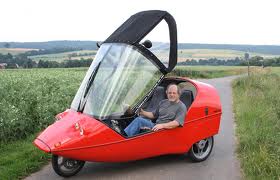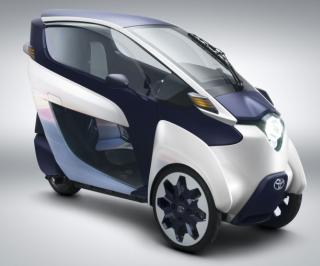A Guide to Mid-Power Vehicles
Is there a Mid-Car in your future?
Low-power vehicles operate within human-power limits, specifically within the capacity of those whom most people would regard as 'very fit' but not necessarily as fit as athletes—the professional or high-end amateur athletes (see Limits of Human Power). The very fit can produce 250 watts over a sustained period, and more for short periods. So low-power vehicles would have a maximum power output of about 500 watts or less and normally operate at under 250 watts. This level of power makes bicycle technology work well (enough) and efficiently.
High-power vehicles are currently just about everything else: all non-toy cars and trucks. The average car comes with a 165,000 watt motor that half of car buyers deem too low-power. Many who settle for an average to below average car wish they could afford an even higher power vehicle. Decades of advertising dollars pay off.
Car Culture pundits think everyone should at least want a mussel car, at least any real American, and that 230 hp (171,580 watts) is minimal for just driving around on the streets. Those wanting high power, however, should choose from the 100 models available that range from a mere 555 hp (414,030 watts) up to a satisfying 1,287 hp (960,102 watts). Those who want more can start with a commercial offering and hot rod it. More is, of course, always better.
The difference between low and high is about three orders of magnitude (1,000 times), which raises the question: is there room for something in between? Anything less than 150 hp (111,900 watts) is tolerantly dismissed as a 'compact' car wantabe. But even the lowest of the low offer at less 75,000 watts of power. That leaves the 500 watt to 75,000 watt space open such that vehicles that occupy this range may be called mid-powered vehicles. Is there a place in the world for them?
To not blur the lines, let's say that mid-power falls in the 1,500 watt to 15,000 watt range (2 hp to 20 hp). Low-power vehicles are partly or wholly human-powered, unlicensed, and inhabit bicycle lanes. Mid-power vehicles would/should be licensed and insured if operated on public roadways. In terms of efficiency and functionality, there is much to be said in favor of mid-power vehicles. If lightweight, aerodynamic, and with up to 20 hp, they could blend in with, match the speed of, high-power vehicles except when going uphill.
All high-power affectionados can be expected to hate and despise them, of course, as they would not 'go fast enough' and worse, would get in the way of the real vehicles currently laying claim to public roads. However, legally, there are only a few sections of interstate highway with posted 40 mph minimum speed limits and there are alternative routes to ply. With a slow moving sign and amber lights flashing, mid-power vehicles could roll on down the road, and the car endowed, like it or not, would have to share the roads. In the long run, car ownership may become so prohibitively expensive that most people will have to drive mid-power vehicles. Until then, become an early adapter.
High-power comes at a high price: fossil fuels. Yes, you could get a 416 hp (310,000 watt) Tesla electric car, but the giant sucking sound it makes as it slurps from the grid (largely powered by fossil fuel) is the same as other cars--it merely guzzles differently. Another cost is that cars kill and injure about twice as many Americans each year as all criminals, murderers, and terrorists put together. The greater harm done, however, is secondary to the loss of health, longevity, and productivity caused by our collective activity intolerance, largely induced by our dependency (which includes psychological) on cars for transportation.
Low-power is an option, but at times low-power may not be quite enough. In the vast gulf between low and high, there is plenty of room to think mid-power. So think lightweight, electric, solar, aerodynamic, mid-power vehicles that get a little help (up to 10%) from human-power (if only to help humans be minimally active) that get around town about as fast as today's over-powered cars, and go about half the speed on highways when going uphill. The other significant limitation would be that, like low-power vehicles, mid-power vehicles would have lots of gears and actually use them to climb hills. Since they would not power up steep slopes like cars, they would climb hills slower, at less than half the speed of today's cars. But getting there may not only be half the fun, it may be better than not getting there at all. Don't assume you'll always be able 'to fill'er up' at the gas pump.
Mid-power comes at a mid-price in both dollars and in harm done to humans and their planet. Having a solar power system at home could recharge a mid-car's batteries. Some solar cells would fit on the mid-car. For long range travel, a mid-car could tow a solar array trailer. Wouldn't go as fast as today's cars, but cross country travel would be doable at half the speed. And when gasoline sells for $99.99/gallon, solar mid-power vehicles may be infinitely faster than most of today's cars that will become lawn ornaments, and much faster than a solar powered horse (and more comfortable to ride too).
Currently there are golf-carts. There are small motorcycles (over-powered bicycles), and for $34K (25K €) there is the Twike which falls within the mid-car range.
Mid-car design: Imagine two persons side by side, a quad using four 26 inch heavy-duty bicycle wheels. The back wheels are human-powered, each wheel by one of the two drivers (if just one person, best to go low-power vehicle). The two front wheels are hub motors, 1000W each. Two motors for redundancy and for four wheel drive. The wheels could have heavy duty spokes and each wheel would carry 300 lbs, so 1200 lb GVW (less than 300 lbs empty). A mid-drive motor assisting the human input would be used for through-the-gears hill climbing. The two hub motors would be used for regen going downhill and power on the flats and moderate slopes. The mid-car would be car-width—all the better to carry solar panels overhead. The body of the mid-car would be an epoxy coated fabric, so thin but rigid and waterproof, such as used on velomobiles. Add gull-doors....suspension. Both riders could steer, and rear facing passenger seats for two kids or adults could be accommodated. For cargo carrying, a trailer could be pulled, and trailer could be a solar array for long trips. Top speed about 30 mph on flats and 10 -15 mph up hill. Range depends of how many batteries. Better batteries will eventually be forthcoming.
 An interesting design for a mid-power to high-power commuter is the Toyota iRoad. Tadpole is better and leaning into turns is needed for stability in turns at speed. An aerodynamic weather enclosure is a plus.
An interesting design for a mid-power to high-power commuter is the Toyota iRoad. Tadpole is better and leaning into turns is needed for stability in turns at speed. An aerodynamic weather enclosure is a plus.
Another design (video below), an electric motorcycle that can do high-power vehicle speed, falls on the line and could be regarded as a high-speed mid-power vehicle able to do highway speeds due largely to reasonable aerodynamics.
It is also reasonable to add pedals to mid or high-power vehicles as an option given the time spent sitting in then and the harm of inactivity they induce. Basically adding pedals is adding a stationary exercise bike to the vehicle. If the pedals crank a generator, then a trivial amount of human power could go to charging the battery or powering the motor.
Imagine an SUV with pedals. Some benefit could be incurred if the driver and passengers pedaled. They almost certainly wouldn't, but any movement would be better exercise than occasionally shifting ones weight in the seat. Now imagine calling the SUV a bicycle because it has pedals that turn a generator that nominally "power" the vehicle. An inconceivable absurdity? A joke? No, many in the car culture are so clueless that they think adding pedals makes a vehicle a bicycle even if the total human power couldn't power the stereo system.
Even if pedaling was used to control the power instead of using a throttle, the result isn't an "awesome revolutionary bicycle (0:28)." At 27 hp (20,000W) and 570 lbs (259 kg) it's not a bicycle or LPV. As a mid-power vehicle it may well be all good, a vision of things to come.
References:
http://www.enginefactory.com/howmuch_hp.htm
http://www.edmunds.com/car-reviews/features/the-100-most-powerful-cars-of-all-time.html